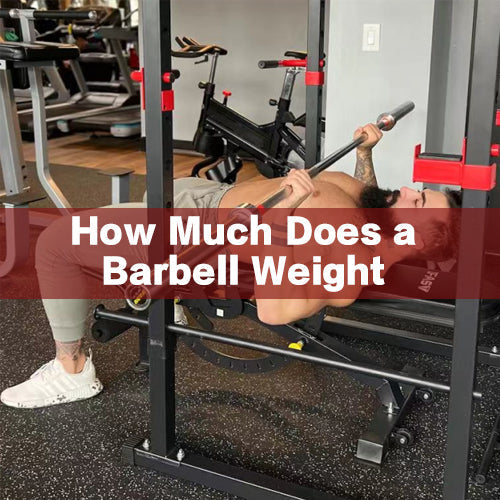Tricep kickbacks are a highly effective exercise for targeting and strengthening the triceps, the muscles located at the back of your upper arms. This isolation exercise is popular among fitness enthusiasts, athletes, and bodybuilders due to its ability to enhance arm definition and improve overall upper body strength.
Here you will know:
- Tricep Kickbacks Muscles Worked
- How to, Variations and Progressions
- Common mistakes of Tricep Kickbacks
- Programming for Peak Tricep Performance
- Equipment Needed for Tricep Kickbacks
- Conclusion
Tricep Kickbacks Muscles Worked
While tricep kickbacks may seem like a simple, straightforward exercise, there's a fascinating anatomical process that occurs to effectively target and work the triceps brachii. Understanding how this movement engages the muscles can help you fully appreciate its effectiveness and execute it with precision.

The Triceps Brachii: A Trio of Power The triceps brachii is a three-headed muscle that occupies approximately two-thirds of the upper arm's overall mass. It comprises three distinct heads:
- Lateral Head (Longhead): The largest and most prominent portion, running along the outer side of the upper arm.
- Medial Head (Medialhead): The smallest of the three heads, located on the inner side of the upper arm.
- Long Head: Originating from the scapula (shoulder blade), this head runs along the length of the upper arm.
During the Tricep Kickback Movement
As you perform a tricep kickback, the concentric (shortening) phase of the movement occurs when you extend your arm backward, straightening it from the elbow joint. This action engages all three heads of the triceps brachii, with the primary focus on the lateral and long heads.
- Lateral Head Activation: The lateral head plays a crucial role in extending the arm, particularly during the kickback motion. As you straighten your arm, the lateral head contracts and generates the necessary force to move the weight or resistance.
- Long Head Engagement: The long head, originating from the scapula, contributes to the extension of the arm and stabilizes the shoulder joint during the kickback movement.
- Medial Head Involvement: While not the primary mover, the medial head also contracts to assist in the extension of the arm, albeit to a lesser degree than the lateral and long heads.
The Eccentric Phase
While the concentric phase targets the triceps during the extension, the eccentric (lengthening) phase also plays a vital role in muscle development. As you lower the weight or resistance back to the starting position, the triceps muscles contract eccentrically to control the movement and resist the force of gravity.
This eccentric contraction places significant stress on the muscle fibers, leading to microscopic tears that ultimately promote muscle growth and strength gains when combined with proper nutrition and recovery.
Tricep Kickbacks: How to, Variations and Progressions
Proper form is crucial when it comes to maximizing the effectiveness of tricep kickbacks and preventing potential injuries.Here are 4 Variations of tricep kickbacks for you.
Dumbbell Tricep Kickbacks
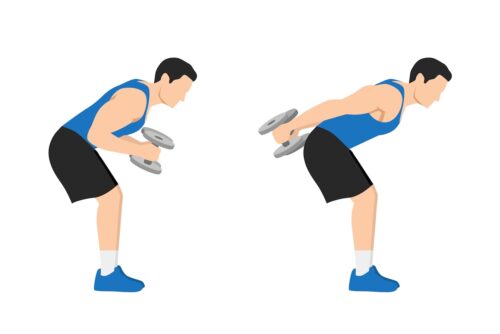
Dumbbell tricep kickbacks are a popular variation of the exercise that can effectively target and strengthen the triceps.
- Stand with feet shoulder-width apart, slight knee bend.
- Hold a dumbbell in each hand, arms hanging by your sides.
- Bend forward at the hips, back parallel to the floor.
- Start with elbows bent at 90 degrees, palms facing each other.
- Extend arms behind you, focusing on contracting the triceps.
- Keep upper arms stationary and close to your sides.
- Fully extend arms until parallel to the floor.
- Slowly return to starting position.
Cable Tricep Kickbacks

- Set up a cable machine with a single-handle attachment at a low position.
- Stand facing the cable machine with your feet shoulder-width apart. Grab the handle with an overhand grip using your right hand.
- Take a step back with your right foot, maintaining a slight bend in your knees. Keep your torso upright and your back straight.
- Start with your right arm bent at a 90-degree angle, upper arm parallel to the floor, and forearm perpendicular to it. This is your starting position.
- Engage your triceps and extend your right arm straight behind you, while keeping your upper arm stationary. Focus on squeezing the triceps at the end of the movement.
- Pause briefly at full extension and then slowly return to the starting position, maintaining control throughout the motion.
- Complete the desired number of repetitions with your right arm before switching sides and repeating the exercise with your left arm.
- Maintain proper posture throughout the exercise, with your core engaged and your back straight.
Learn More: 10 cable workouts for bigger arm
Resistance Band Tricep Kickbacks
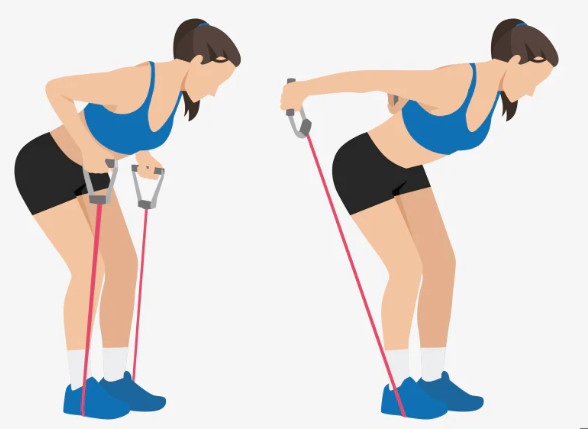
- Secure one end of the band under your feet.
- Hold the other end in one hand, palm facing inwards.
- Keep your elbow close to your side and your upper arm parallel to the floor.
- Extend your arm fully, pushing the band backward.
- Return to the starting position with control.
- Adjust the band's resistance as needed for your fitness level.
- Focus on proper form and breathing throughout the exercise.
Single-Arm Tricep Kickbacks
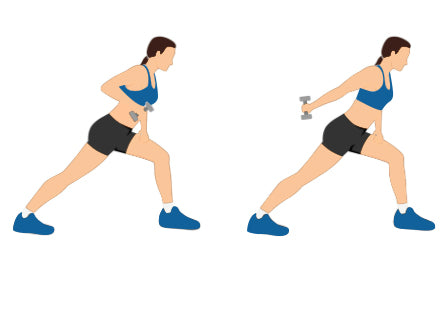
- Stand with your feet shoulder-width apart and hold a dumbbell in your right hand.
- Take a step forward with your left foot and slightly bend your knees.
- Bend forward at the hips, keeping your back straight and parallel to the floor. Rest your left hand on your left thigh for support.
- Start with your right arm bent at a 90-degree angle, upper arm parallel to the floor, and forearm perpendicular to it. This is your starting position.
- Engage your triceps and extend your right arm straight behind you while keeping your upper arm stationary. Focus on squeezing the triceps at the end of the movement.
- Pause briefly at full extension and then slowly return to the starting position, maintaining control throughout the motion.
- Complete the desired number of repetitions with your right arm before switching sides and repeating the exercise with your left arm.
Seated Tricep Kickbacks

- Sit on a chair or bench with your feet flat on the floor and your back straight.
- Hold a dumbbell in each hand, palms facing inward, and lean forward slightly from your hips.
- Keep your elbows close to your sides and your upper arms parallel to the floor.
- Extend your arms fully behind you, straightening them out while keeping your elbows stationary.
- Squeeze your triceps at the top of the movement, then slowly lower the weights back to the starting position.
Common mistakes of Tricep Kickbacks
1.Using Momentum/Swinging the Weight
❌Mistake: Swinging the dumbbell by using momentum from the legs and hips instead of the triceps.
✅ Fix: Keep your body stable, brace your core, and use slow, controlled motions. The triceps should be doing all the work.
2.Improper Arm Position
❌Mistake: Allowing the upper arm to drift away from the body or move during the kickback.
✅ Fix: Keep your upper arm stationary and tucked close to your side throughout the movement. Only your forearm should move.
3.Raising the Weight Too High
❌Mistake: Bringing the dumbbell up past shoulder level on each rep.
✅ Fix: Only raise the weight until your arm is parallel to the floor. Going higher can impinge the shoulder.
4.Arched Lower Back
❌Mistake: Over-arching the lower back to try and get more range of motion.
✅ Fix: Maintain a neutral spine by hinging at the hips and bracing your core. Don't excessively arch or lean.
5.Using Too Much Weight
❌Mistake: Sacrificing form by using a weight that's too heavy.
✅ Fix: Go lighter on the weights to properly isolate the triceps. Use a weight you can control for 10-15 reps.
6.Rushing the Eccentric (Lowering) Portion
❌Mistake: Letting the weight drop quickly instead of lowering under control.
✅ Fix: Lower the weight slowly and with control to maximize the eccentric (lengthening) contraction.
7.Lack of Mind-Muscle Connection
❌Mistake: Not focusing on contracting and squeezing the triceps during the movement.
✅ Fix: Concentrate on flexing the triceps throughout each rep for full muscle engagement.
Programming for Peak Tricep Performance
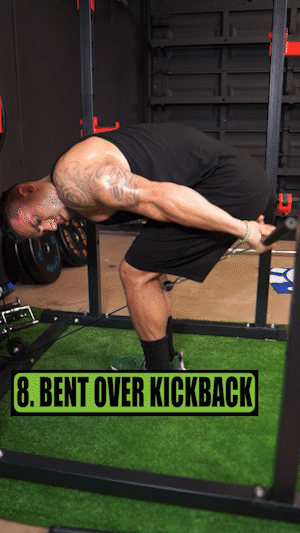
Proper programming is essential to maximize the benefits of tricep kickbacks and achieve your desired results. Here are some programming tips to consider:
Rep Ranges: For hypertrophy (muscle growth) and toning, aim for a rep range of 10-15 reps per set. If you're prioritizing strength, opt for lower reps (6-8) with heavier weights.
Set Structure: Incorporate tricep kickbacks towards the end of your arm or upper body routine, after compound exercises like bench presses or push-downs. Aim for 3-4 sets per workout.
Frequency: Train your triceps 2-3 times per week, allowing for adequate rest and recovery between sessions.
Progressive Overload: Gradually increase the weight, reps, or sets over time to continually challenge your muscles and promote growth.
Superset or Triset: To amplify the intensity and metabolic demand, consider supersetting or trisetting tricep kickbacks with other isolation exercises like bicep curls or lateral raises.
Mind-Muscle Connection: Throughout your sets, maintain a strong focus on contracting and squeezing your triceps muscles during each rep. This mind-muscle connection can enhance overall engagement and results.
Remember, consistency and progressive overload are key to achieving meaningful progress. Don't be afraid to experiment and tweak your programming to find what works best for your specific goals and body.
Equipment Needed for Tricep Kickbacks
When performing tricep kickbacks, having the right equipment ensures proper form and maximizes the effectiveness of the exercise. Here's the essential equipment you'll need:
- Dumbbells
- Bench or Chair
- Cable Machine with Low Pulley Attachment
- Resistance Bands
- Exercise Mat
Dumbbells: Choose dumbbells of an appropriate weight that challenge your triceps without compromising your form. Opt for a weight that allows you to perform the desired number of repetitions with proper technique. Adjustable dumbbells are ideal for adjusting the resistance as needed.
Bench or Chair: While not always necessary, a weight bench or chair can provide stability and support during seated tricep kickbacks. Ensure that the bench or chair is sturdy and positioned on a flat surface to prevent wobbling or tipping over.
Cable Machine with Low Pulley Attachment: Cable machines equipped with a low pulley attachment offer a great alternative for performing cable tricep kickbacks. The pulley system provides constant tension throughout the range of motion, challenging your triceps from start to finish.
Resistance Bands (Optional): For added resistance and variety, you can incorporate resistance bands into your tricep kickback routine. Attach one end of the band to a stable anchor point and hold the other end while performing the exercise. This option is convenient for home workouts or when access to traditional weights is limited.
Exercise Mat (Optional): If performing tricep kickbacks on the floor or in a kneeling position, an exercise mat can provide cushioning and support for your knees and elbows. It helps prevent discomfort or strain, especially during longer workout sessions.
Conclusion
If you want to get fitter, bigger arms and better results from your workout schedule, learning how to tricep kickbacks the right way can give you an edge. You’ll need to understand the ideal form for this move, as well as which variations approach can be a good training option and what benefits you’ll get if you’re consistent with your technique. When is it best to lift lighter loads, and when should you increase the weight on the bar? Just remember to listen to your body, and avoid the most common mistakes. Tricep kickbacks will become your best friend. Soon, people will ask: ‘Well, where did you get those sexy swole arms, fellow?’So, grab those dumbbells or cables, focus on the triceps, and kick your way to tricep greatness!
FAQs
What muscles do tricep kickbacks target?
Tricep kickbacks primarily work the triceps brachii, which is made up of three heads - the lateral, medial, and long heads. The lateral head is most emphasized during kickbacks.
How do I properly set up for tricep kickbacks?
Stand with feet shoulder-width apart, knees slightly bent. Hinge forward at the hips, keeping your back flat. Hold a dumbbell in one hand with arm extended and elbow tucked.
What's the proper form for tricep kickbacks?
Initiate by extending at the elbow, straightening your arm back until it's parallel to the floor, squeezing the triceps. Slowly re-bend the elbow to return to start.
Should I alternate arms or do one arm at a time?
You can do kickbacks one arm at a time, or alternate between arms for each rep. One arm can help focus on the mind-muscle connection.
Where should I feel tricep kickbacks?
You should feel kickbacks primarily in the triceps, especially the lateral head on the back of the upper arm. Avoid feeling it in your shoulders or chest.
How heavy should the weight be for kickbacks?
Use a reasonable weight that allows 10-15 reps with strict form. Women often use 5-15 lbs, men 10-30 lbs. Increase weight gradually over time.
How many sets/reps of kickbacks should I do?
For muscle growth, aim for 3-4 sets of 10-15 reps. For strength, do 3-5 sets of 6-8 reps with heavier weight. Adjust based on your goals.
Are there any good variations of tricep kickbacks?
Try kickbacks with cables, resistance bands, kettlebells, from a bench, or single-arm dumbbell kickbacks to add variety.
When should I do tricep kickbacks in my workout?
Kickbacks are usually done towards the end of a push, arm or upper body day after compound pressing movements.


